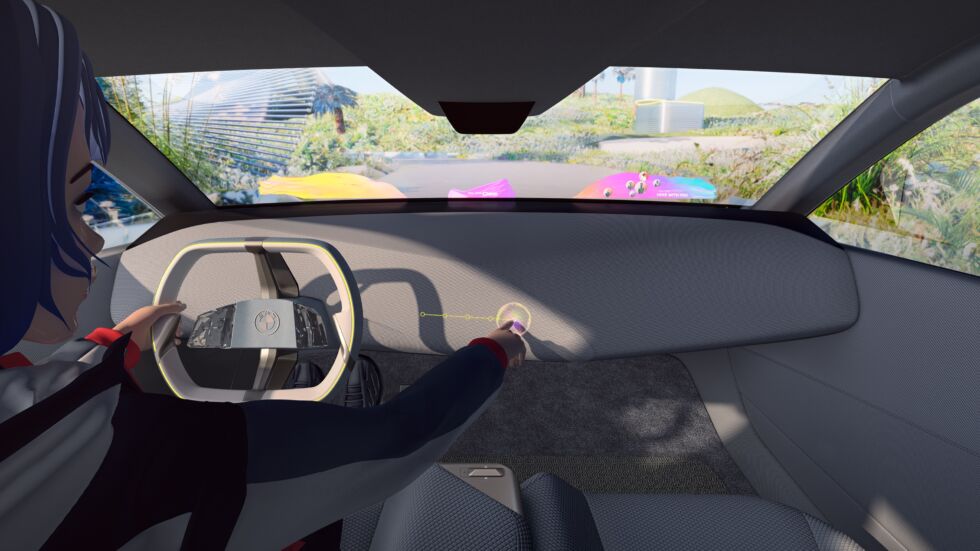
I'm almost sad to not be in Las Vegas for the annual Consumer Electronics Show, and for the second year running, that fear of missing out is due to a new augmented reality display for cars. Last year, it was a new in-plane holographic optical element display from Texas Instruments that projects an image onto the surface of the windshield, unlike a traditional head-up display, which throws a smaller image out into space ahead of the driver.
This year, it's a new BMW concept car that previews some of the tech we'll see in the company's Neue Klasse EVs, which will feature full-windshield augmented reality when they go into production in 2025.
The concept is called the BMW i Vision Dee, with the "Dee" standing for "digital emotional experience" rather than suggesting that BMW designers are fans of It's Always Sunny in Philadelphia.

It's a companion piece to the BMW i Vision Circular we saw in 2021. That concept explored more sustainable manufacturing; this one tries out new human-machine interface ideas, including a mixed-reality slider that lets drivers decide how much digital content they want the car to show them, with everything from basic driving information to virtual worlds being projected onto the windows—of course, that mode is only meant for use with autonomous driving.
"With the BMW i Vision Dee, we are showcasing what is possible when hardware and software merge. In this way, we are able to exploit the full potential of digitalization to transform the car into an intelligent companion," said BMW Chairman Oliver Zipse. "That is the future for automotive manufacturers—and, also, for BMW: the fusion of the virtual experience with genuine driving pleasure. At the same time, BMW i Vision Dee is another step on the road to the Neue Klasse. With this vision, we are looking far into the future and underlining the tremendous importance of digitalization for our upcoming product generations."
-
The i Vision Dee is a minimalist three-box shape. Click through this gallery for more details.BMW
-
The i Vision Dee can project content onto the side windows, dimming them in the process. Somehow, I don't think this feature will make it to production.BMW
-
The shape of the rear window is known as the "hofmeister kink," and like the kidney grille, it's a BMW design signature.BMW
-
The front grille covers have e-ink panels and also contain the headlights.BMW
-
The rear lights blend into the bodywork.BMW
-
BMW has had some experience using e-ink panels on cars.BMW
I'm not sure how much the shape of the i Vision Dee will translate to a production Neue Klasse sedan—BMW is planning multiple models and versions of the new EV platform, much like it did with the original Neue Klasse sedans and coupes in the 1960s and 1970s. But I hope the minimalist approach to styling survives, as I find the exterior shape rather fetching.
Interior renderings show a heavy use of "shy tech," something we first saw from BMW with the Vision iNext, a concept that became the production iX. BMW calls this "reductive design"; it hides touch controls behind trim and generally makes them disappear from sight when not in use.
I'm less certain we'll see some of the Dee's other ideas in production. While full-windshield augmented reality displays are in the works, until the advent of actual autonomous driving systems sold in consumer cars (as opposed to robotaxis like Waymo), I'm not sure there will be demand for windows that can dim to block the outside world, although if the car can drive itself, turning that space into displays for the occupants could come in quite handy if you get stuck in heavy traffic.

Still, the implementation in the Dee seems quite clever, with a slider that the driver can use to move through five stages of information display. The most basic of these shows the information you'd need while driving—speed, directions, and so on. More information-dense stages add in infotainment and communications, then augmented reality, and finally, that fully virtual world that blocks out the real one (at least temporarily).
The Dee also features some exterior display tech, too. BMW is keeping its traditional kidney grille as the face of its vehicles, but here, it's in the form of an active grille that closes off the nose when cooling is not needed. The surfaces of the grille covers are e-ink displays that, together with the headlights, can create different "facial" expressions for the car.
It's not the first time we've seen an idea for cars using visual cues to communicate with other road users and pedestrians, and it's unlikely to be the last. In fact, the entire car is covered in e-ink panels—240 individually controlled segments, each of which can display up to 32 colors.
"With BMW i Vision Dee, we are showing how the car can be seamlessly integrated into your digital life and become a trusty companion. The vehicle itself becomes your portal to the digital world—with the driver always in control," said Adrian van Hooydonk, head of BMW Group Design. "Implemented the right way, technology will create worthwhile experiences, make you a better driver, and simply bring humans and machines closer together."
reader comments
116